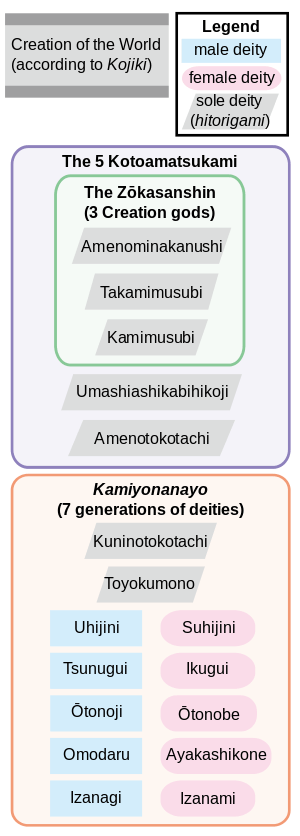Japanese creation myth

In Japanese mythology, the Japanese creation myth (天地開闢, Tenchikaibyaku literally "creation of heaven and earth"), is the story that describes the legendary birth of the celestial and earthly world, the birth of the first gods and the birth of the Japanese archipelago.
This story is described first hand at the beginning of the Kojiki, the first book written in Japan (712), and in the Nihon Shoki (720). Both form the literary basis of Japanese mythology and Shinto; however, the story differs in some aspects between these works, with the most accepted for the Japanese being the one of the Kojiki.
Story
At the beginning the universe was immersed in a beaten and shapeless kind of matter (chaos), sunk in silence. Later there were sounds indicating the movement of particles. With this movement, the light and the lightest particles rose but the particles were not as fast as the light and could not go higher. Thus, the light was at the top of the Universe, and below it, the particles formed first the clouds and then Heaven, which was to be called Takamagahara (高天原, "High Plain of Heaven"). The rest of the particles that had not risen formed a huge mass, dense and dark, to be called Earth.[1]
When Takamagahara was formed, the first three gods of Japanese mythology appeared:[2]
- Amenominakanushi (天之御中主神)
- Taka-mi-musuhi-no-kami (高御産巣日神) and
- Kami-musuhi-no-kami (神産巣日神).
Subsequently two gods emerged in Takamagahara from an object similar to a reed-shoot:[2]
- Umashi-ashi-kabi-hikoji-no-kami (宇摩志阿斯訶備比古遅神) and
- Ame-no-toko-tachi-no-kami (天之常立神)
These five deities, known as Kotoamatsukami, appeared spontaneously, did not have a definite sex, did not have a partner (hitorigami) and went into hiding after their emergence. These gods are not mentioned in the rest of the mythology.[2]
Kamiyonanayo
Then two other gods arose:[3]
- Kuni-no-toko-tachi-no-kami (国之常立神) and
- Toyo-kumo-no-no-kami (豊雲野神)
These gods also emerged spontaneously, did not have a defined sex, did not have a partner, and hid at birth.[3]
Then, five pairs of gods were born (for a total of ten deities), each pair consisting of a male deity and a female deity:[3]
- U-hiji-ni (宇比地邇神) and his younger sister (and wife) Su-hiji-ni (須比智邇神),
- Tsunu-guhi (角杙神) and his younger sister (and wife) Iku-guhi (活杙神),
- Ō-to-no-ji (意富斗能地神) and his younger sister (and wife) Ō-to-no-be (大斗乃弁神),
- Omo-daru (於母陀流神) and his younger sister (and wife) Aya-kashiko-ne (阿夜訶志古泥神) and
- Izanagi (伊邪那岐神) and his younger sister (and wife) Izanami (伊邪那美神)
All deities from Kuni-no-koto-tachi to Izanami are collectively called Kamiyonanayo (神世七代, "Seven Divine Generations").[3]
Following the creation of Heaven and Earth and the appearance of these primordial gods, Izanagi and Izanami went on to create the Japanese archipelago (Kuniumi) and gave birth to a large number of gods (Kamiumi).[4]
References
- ↑ Chamberlain 2008, pp. 67–70
- 1 2 3 Chamberlain 2008, p. 71
- 1 2 3 4 Chamberlain 2008, p. 72
- ↑ Chamberlain 2008, pp. 73–86
Bibliography
- Chamberlain, Basil Hall (2008). The Kojiki: Japanese Records of Ancient Matters. Forgotten Books. ISBN 978-1-60506-938-8. Retrieved 9 February 2011.
- "Génesis del mundo y aparición de los primeros dioses" [Genesis of the world and appearance of the first gods] (PDF) (in Spanish). Archived from the original (PDF) on 2007-11-10.

